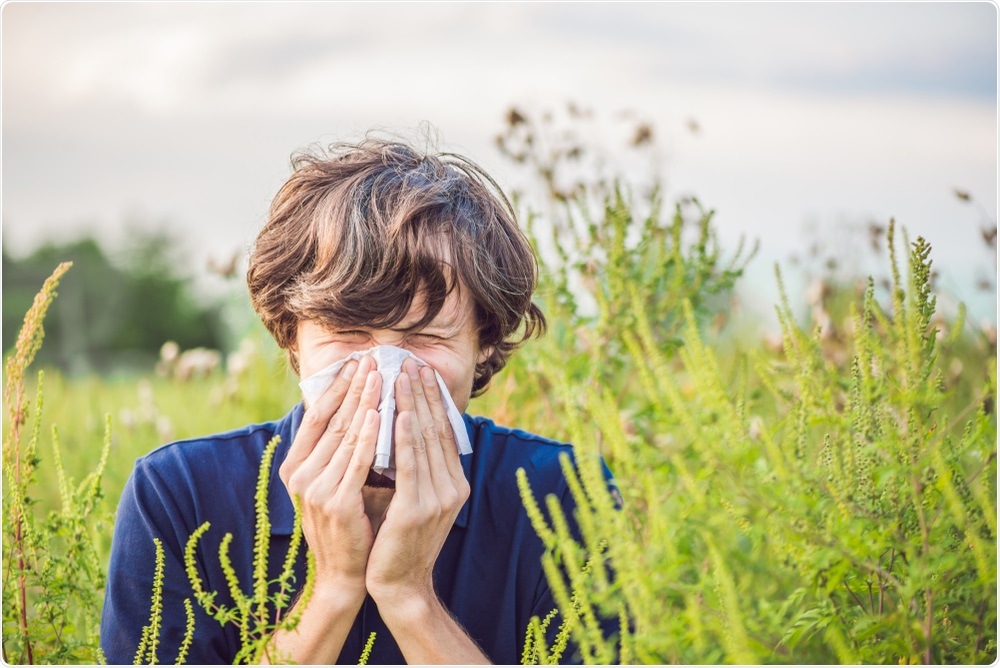AZoLifeSciences speaks to Dr.Urs Schaffner about his latest research into relieving allergy sufferers.
What provoked your research into allergies?
In 2012 we started with an EU COST Action on Ambrosia. Ambrosia can cause problems as a weed in crop fields, but the main reason why it is one of the most troublesome invaders in Europe is the impact of the highly allergenic pollen on human health.
It was clear to us that sustainable management of a plant invader that impacts human health and agriculture needs to be developed by an interdisciplinary team consisting of ecologists, aerobiologists, medical doctors and economists.
So, we were in a lucky situation to be well prepared to respond to the accidental introduction of O. communa in Europe.
What allergies does pollen cause?
Allergic disease is a key public health problem that has increased rapidly in recent decades, in both developed and developing countries, and it is now recognized as a major global epidemic.
Ragweed pollen is a major risk factor for allergic diseases such as allergic rhinoconjunctivitis and asthma.

Image Credit: Elizaveta Galitckaia/Shutterstock.com
How does ragweed pollen cause these allergies?
Ragweed pollen are very small pollen grains that easily get into the upper airways. Even small amounts of Ambrosia pollen can trigger severe allergic reactions, including asthma.
This is why experts describe Ambrosia pollen as particularly aggressive.
How does the leaf beetle Ophraella communa reduce pollen?
Both adults and larvae of the leaf beetle Ophraella communa feed on ragweed plants. They can defoliate plants entirely, thus preventing the formation of inflorescences.
If the plant produces flower buds, the beetle can also feed on them.
How is the beetle being implemented into research?
In the 1970s, Australian scientists became interested in this beetle as ragweed started invading Australia. They conducted host-range testing with O. communa to assess whether the introduction of this beetle might cause harm to crop plants or native Australian plants. They found that, under laboratory conditions, the beetle can complete its development on a sunflower.
Australia, therefore, did not approve the field release of O. communa. Then, in the 1990s, the beetle got accidentally introduced in Japan, from where it also spread to China.
In China, the beetle started to defoliate ragweeds and was, therefore, subject to further research on its potential risks on sunflowers. Field studies showed that O. communa does not attack sunflowers in China under field conditions.
The Chinese then started mass-rearing and mass-releasing the beetle for biological control of ragweed, and this is continuing today.
And then, to our surprise, the beetle was detected in Europe in 2013. As mentioned above, our interdisciplinary COST Action team was ready to implement studies on the potential benefits and risks of this new arrival in Europe.
What could this mean for allergy sufferers?
We already know from northern Italy that the pollen concentration (and also the number of days where pollen concentration reaches the threshold where sensitized people express symptoms) dropped in 2013, when the beetle built up for the first-time high population densities.
In our paper, we provided results from a field experiment where we demonstrated that the beetle reduces pollen output of ragweed plants by 80% and more.
So, wherever this beetle can build up high population densities, a large number of allergy sufferers will have no or fewer allergies due to ragweed.
Allergies are a huge economic cost each year. Do you believe this beetle could help to reduce these costs?
The beetle will be able to reduce costs related to ragweed allergies in those areas in Europe where it can complete at least 3 generations.
Since the beetle needs quite warm temperatures, this will be almost exclusively in southern and southeastern parts of the distribution range of common ragweed in Europe.
What is next in your research into allergies?
We are currently assessing how climate change will affect the distribution of the weed and the beetle, and whether the beetle’s impact on pollen production by A. artemisiifolia will increase or decrease in the future.
Where can readers find more information
Besides the link to our paper in Nature Communications included in the press release, we would like to suggest the following references for more information:
- Müller-Schärer H., Lommen S.T.E., Rossinelli M., Bonini M., Boriani M., Bosio G., Schaffner U., 2014. Ophraella communa, the ragweed leaf beetle, has successfully landed in Europe: fortunate coincidence or threat? Weed Research 54: 109-119.
- Shaw, R.H., Ellison, C.A., Marchante, H., Pratt, C.F., Schaffner, U., Sforza, R.F. and Deltoro, V., 2018. Weed biological control in the European Union: from serendipity to strategy. BioControl, 63(3), pp.333-347.
About Dr. Urs Schaffner
Urs is head of the ‘Ecosystems Management’ section at CABI in Switzerland and Affiliate Assistant Professor at the University of Idaho, USA. His research focuses on soil-plant-herbivore relationships, with a focus on biological invasions, biological control of weeds and ecosystem restoration.

Urs has been and is involved in several applied research projects in Europe, North America, Asia, and Africa.
Currently, he leads an international project with ten research institutions on assessing the effects of invasive plant species in Eastern Africa and implementing management strategies that mitigate their negative impacts on ecosystems and rural livelihoods.